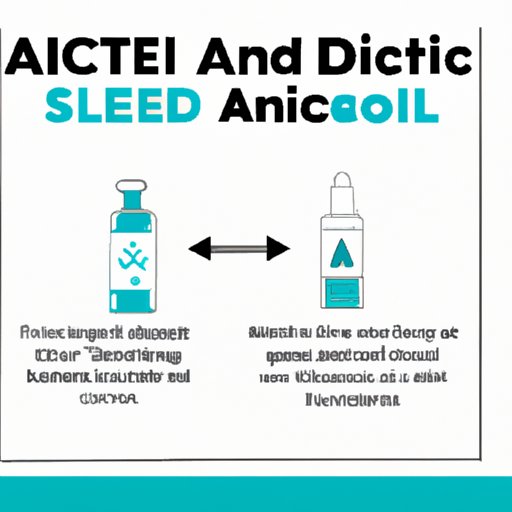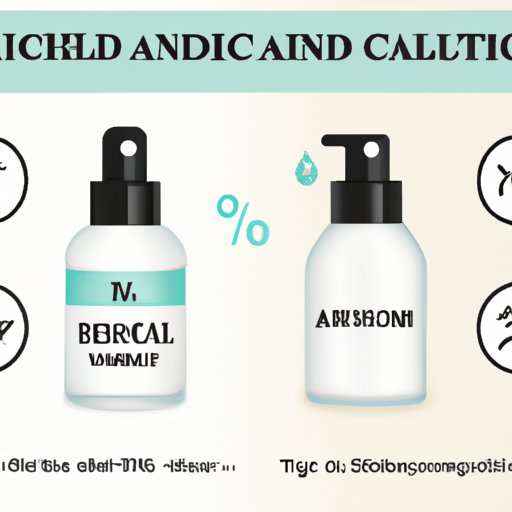Introduction
Combining skincare products may seem like a great way to get the most benefits out of your routine, but it can also be a risky move. The question often comes up: can you use salicylic acid with retinol? In this article, we will explore this topic and provide you with everything you need to know before combining these two skincare heavyweights.
The Ultimate Guide to Using Salicylic Acid and Retinol Together
Before diving into the question of whether salicylic acid and retinol can be used together, it’s essential to understand what these ingredients are and how they benefit your skin.
What is Salicylic Acid?
Salicylic acid is a beta-hydroxy acid that is oil-soluble, making it perfect for targeting acne, blackheads, and congested pores. It gently exfoliates the skin, removing dead skin cells and boosting cell turnover, keeping the pores clear and preventing new blemishes.
What is Retinol?
Retinol is a form of Vitamin A that helps promote cell turnover, smoothing fine lines and wrinkles and stimulating collagen production. It can help reduce hyperpigmentation, unclog pores, and regulate sebum production.
Individual Benefits of Salicylic Acid and Retinol
While these two ingredients are mighty in their own right, each has a set of unique benefits that can help your skin look its best.
Benefits of Salicylic Acid:
- Unclogs pores and reduces the appearance of blackheads and whiteheads
- Gentle exfoliation removes dead skin cells, clearing the way for healthy skin
- Reduces inflammation and soothes irritated skin
- Can help even out skin tone and reduce hyperpigmentation
Benefits of Retinol:
- Stimulates collagen production, reducing the appearance of fine lines and wrinkles
- Can improve the appearance of hyperpigmentation, melasma, and post-inflammatory hyperpigmentation
- Improves skin texture, reducing the appearance of scarring
- Regulates sebum production and can help prevent acne
Potential Benefits of Using Salicylic Acid and Retinol Together
Combining salicylic acid and retinol in your skincare routine can provide a wide array of benefits. The salicylic acid helps keep the pores clear and prevents breakouts, while the retinol helps to stimulate collagen production and reduce the appearance of fine lines and wrinkles. Together these two ingredients can help reduce the appearance of scarring and uneven skin tone.
Are Salicylic Acid and Retinol a Match Made in Skincare Heaven?
One of the concerns with using salicylic acid and retinol together is that they may cause skin irritation. However, when used correctly, these two ingredients can actually be complementary to each other.
Possible Side Effects
The primary concern with using both salicylic acid and retinol together is the potential for irritation, especially if you have sensitive or dry skin. Symptoms of irritation can include redness, peeling, flaking, and dryness.
Why They Can Be Complementary
If you have issues with acne and fine lines, combining these two ingredients can go a long way. Salicylic acid can help keep the pores clean and unclogged, which can help reduce the amount of sebum and bacteria on the skin’s surface. In contrast, retinol helps to plump up the skin and stimulate collagen production, which can smooth out fine lines and wrinkles.

Expert Tips on How to Safely Combine Salicylic Acid and Retinol
If you’re interested in incorporating salicylic acid and retinol into your skincare routine, there are some important tips to keep in mind to ensure that you’re using them safely.
How to Incorporate Each Ingredient into Your Routine
First, it’s essential to introduce each ingredient into your routine slowly. Start with one ingredient, and once your skin has adjusted, introduce the other. It’s also important to avoid using both ingredients at the same time of day. Use salicylic acid in the morning and retinol at night to reduce the risk of irritation.
Minimizing Potential Irritation
To minimize the potential for irritation, start with a low percentage of each ingredient, and gradually increase as your skin adjusts. It’s also crucial to use a moisturizer to help hydrate the skin and reduce the likelihood of dryness and peeling. Look for gentle, fragrance-free products that won’t further irritate the skin.

Why You Might Want to Add Salicylic Acid to Your Retinol Regimen
If you’re currently using retinol, there are some compelling reasons to consider adding salicylic acid to your routine to target stubborn pimples, blackheads, or other skin concerns that retinol alone may not be able to address.
Addresses acne
If you are struggling with acne or congested skin, it’s incredibly beneficial to add salicylic acid to your routine. Salicylic acid can help deep-clean the pores and remove any debris that may be causing breakouts.
Fights hyperpigmentation
Salicylic acid can also help address hyperpigmentation, particularly post-inflammatory hyperpigmentation (PIH) and melasma. By exfoliating the skin, it can help remove dead skin cells that may contribute to hyperpigmentation and even out skin tone over time.
Debunking the Myths of Using Salicylic Acid and Retinol Together
There are a few common myths and misconceptions when it comes to using salicylic acid and retinol together. Here, we’ll break down some of the most prevalent.
Myth: Salicylic Acid and Retinol Cancel Each Other Out
While it’s true that both of these ingredients are powerful, they don’t necessarily cancel each other out. In fact, they can work together to provide a wide range of benefits, including reducing acne, improving skin texture, and reducing the appearance of fine lines and wrinkles.
Myth: Salicylic Acid and Retinol Can’t Be Used Together
Although it’s true that you need to be cautious when using these ingredients together, they are perfectly safe to use. Just ensure that you’re introducing them slowly and giving your skin time to adjust.

The Pros and Cons of Combining Salicylic Acid and Retinol
As with any skincare product or ingredient, there are pros and cons to using salicylic acid and retinol together.
Benefits of Using Salicylic Acid and Retinol Together
- Addresses multiple skin concerns at once (acne, fine lines, hyperpigmentation)
- Can help smooth and refine skin texture
- Can reduce scarring and discoloration
Potential Drawbacks of Using Salicylic Acid and Retinol Together
- May cause skin irritation or dryness if not used correctly
- Can be overwhelming for the skin if introduced too fast
Is It Right for You?
If you’re interested in combining salicylic acid and retinol in your skincare routine, it’s essential to consider whether it’s the right decision for your skin type and concerns. Talk to a dermatologist if you’re unsure about how to proceed.
The Dos and Don’ts of Mixing Salicylic Acid and Retinol in Your Skincare Routine
Finally, here are some clear guidelines to remember when it comes to safely using salicylic acid and retinol together.
DO:
- Introduce each ingredient slowly
- Use a low percentage and gradually work up to higher strength
- Moisturize the skin to prevent dryness and peeling
- Use a gentle, fragrance-free product to minimize irritation
DON’T:
- Use both ingredients at the same time of day
- Use both ingredients every day
- Introduce both ingredients at once
- Use on sensitive or broken skin
Conclusion
So, can you use salicylic acid with retinol? The answer is yes, but with caution. By introducing these ingredients slowly and providing proper hydration and protection, you can target a wide range of skincare concerns and experience beautifully glowing skin.
If you’re interested in trying the combination, remember to start slow, listen to your skin, and consult with a dermatologist if you’re unsure about how to proceed.
